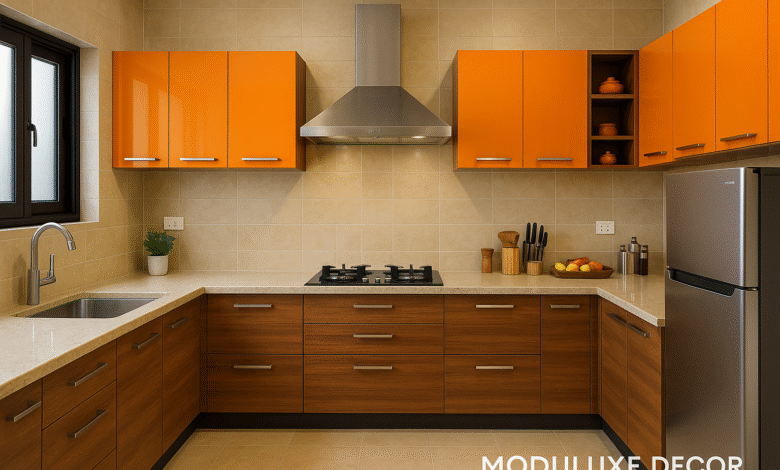Indian Style Small Modular Kitchen Design – Moduluxe Decor
Mistakes to Avoid When Designing a Modular Kitchen

Indian Style Small Modular Kitchen Design – Moduluxe Decor
Mistakes to Avoid When Designing a Modular Kitchen: Creating your dream kitchen is always an exciting and enjoyable experience. We all want to furnish it with the best features and finishes. However, sometimes we get carried away by looks alone, and after using the kitchen for a while, we realise that its functionality could have been much better.
In today’s article, I’ll be sharing some common mistakes to avoid when designing your kitchen. I’ve been actively using my kitchen for the past four years, and I’ll also share a few things I wish I had done differently.
Let’s get started!
Cooktops and Burner Placement:
Fixed cooktops, or hobs, look stylish thanks to their sleek design and neat finish. However, during design and installation, it’s essential to ensure there’s sufficient space between the backsplash and the rear burners. If this gap is too narrow, it becomes difficult and often impractical to place large vessels near the back burners.
As a result, the front burners end up being overused, while the rear burners remain underused or entirely unused.
So, how much space is ideal?
A good rule of thumb is to keep the largest vessel you regularly use, such as your biggest pressure cooker or kadhai, in mind when determining the gap. This is especially crucial if you have a large family or often cook in large quantities.
If your countertop’s width doesn’t allow enough room, it may be more practical to choose a three-burner cooktop instead of squeezing in four burners with limited space.
In my kitchen, this hasn’t been a major issue because I have a small family and don’t cook in large quantities daily. However, I do find myself wishing for a bit more space when I’m preparing meals for guests or hosting gatherings.
Plug Points in the Kitchen:
If you’re fond of using kitchen appliances, you’ll quickly realise there’s no such thing as too many plug points and switches. Jokes aside, it’s important to give serious thought to the number of plug points you’ll need, not just for daily use but also for occasional appliances. Even more crucial is placing them in spots that are convenient, accessible, and free from obstructions.
In my kitchen, I made sure to have enough plug points on the countertop. However, two placements were overlooked during the planning stage:
-
Fridge Plug Point: The original socket for the refrigerator was placed directly behind it. This turned out to be completely impractical. If I ever needed to switch the fridge off manually, I’d have to move the heavy appliance or access the main circuit box. We ended up installing an external switch later, which works but doesn’t look very neat.
-
Microwave Switch: Similarly, the switch for the microwave is tucked behind the appliance, making it inconvenient to reach. It’s a small oversight, but something that could have been easily avoided with better planning.
These are the kind of minor details that can make a big difference in everyday usability. I hope you’ll take a moment to consider them and avoid making the same mistakes.
Pantry Planning:
A tall pantry unit can be incredibly useful for keeping all your groceries organised in one place. While many modern built-in pantry designs with sleek wire shelves look great, they don’t always offer the best practicality.
Wire-based pantry shelves often take up a lot of space but offer poor versatility. They’re not ideal for storing large containers, bulk items, or odd-shaped packets. A friend of mine recently realised this the hard way, despite having a large pantry, she still needed to use overhead cabinets for jars and spices because the wire shelves couldn’t accommodate them properly.
I was fortunate to identify this issue early and got my pantry customized to suit my specific needs. I opted for simple shelves and tandem drawers, which are far more practical and offer flexible storage for a wide variety of items.
Sometimes, the simplest solutions are the most effective. Customizing your pantry with usability in mind rather than just aesthetics will serve you better in the long run.
Practical Kitchen Sink
A lot of you have asked whether a small sink in the kitchen, especially near the cooktop, is good or not. Well, that sink isn’t meant for washing utensils; it’s specifically for rinsing vegetables and washing hands while cooking. And I must say, it’s incredibly helpful for that purpose!
For washing utensils, we have a separate, dedicated sink in the utility area.
Now coming to the point, whichever size or location you choose for your kitchen sink, make sure it doesn’t have raised edges without any slope or passage to direct water back into the sink. Water and spills can accumulate around such edges, making the surface messy and harder to clean.
Opt for sinks with flush edges, or at least ensure some part of the periphery is level with the countertop. This helps direct spills back into the sink and makes maintenance easier.
Vegetable Storage: What Works and What Doesn’t
Pull-out wicker or cane baskets are quite popular in modular kitchens for storing onions and potatoes. They look good initially, but over time, they tend to collect dust and grime and lose their shine.
My personal preference is perforated metal baskets. They’re easy to remove, clean, and wash. Plus, the holes promote good air circulation, which is essential for storing veggies properly.
Some of you have asked about these baskets, and I’ve shared the link here. Whether you choose perforated or wicker baskets is up to you, but the key idea is to prioritize air circulation and ease of maintenance.
Also, if you’re planning concealed vegetable storage, don’t forget to install vents on the cabinet doors. These vents allow airflow and help your vegetables last longer. I also recommend installing vents under the sink area to prevent moisture build-up and potential fungal growth from the drainage pipe.
Maintaining a White Kitchen:
A white kitchen feels like a dream to me; it looks classy and aesthetically appealing. It’s a myth that white kitchens are hard to maintain. In reality, most of it comes down to simple discipline and cleaning habits.
When selecting materials during construction, go for high-quality options. Avoid flimsy or low-grade laminates, as they tend to stain easily and are harder to clean. For white kitchens, I recommend either acrylic laminates (which are steam-resistant) or lacquered glass, though both can be on the pricier side.
There may be more affordable options available now. Check with your designer and always ask to see physical samples before making a decision. Ultimately, your cleaning habits matter more than the materials themselves.
Tandem Drawers:
Tandem drawers are a feature in most modular kitchens these days. The real question is, how many do you need?
In some kitchens, I’ve seen only 2–3 tandem drawers, which simply isn’t enough. I suggest keeping one or two cabinets and dedicating the rest to tandem drawers. They are incredibly convenient; everything stored inside is visible from the top, making access easy.
They can also hold a good amount of weight, so no need to worry about load capacity. Get a mix of different sizes to accommodate all types of cookware and utensils.
Also, before you order your plate rack, check the size of the full plates or thalis you use at home. Many racks cannot accommodate large thalis with broad rims, and that ends up wasting valuable space.
Plan for Big Appliances:
If you’re planning to buy any large kitchen appliance in the future (like a dishwasher, oven, etc.), make sure to leave proper space for it during the interior planning phase. It’s better to double and triple-check the dimensions of the appliance and the available space.
Ensure there’s enough room for door clearance, ease of access, and cleaning. Retrofitting new appliances later can be frustrating, time-consuming, and expensive.
Backsplash Tips:
For your kitchen backsplash, you can choose from tiles, glass, quartz, etc. My recommendation? Choose plain, smooth surfaces. Avoid tiles with grooves, cuts, or overly intricate designs.
While printed tiles are fine if you like the look, make sure the surface is easy to wipe clean. Grooved tiles tend to collect oil stains and splashes from cooking, and become a pain to maintain, whereas smooth surfaces are easy to wipe and keep looking fresh.
Customise to Your Needs:
Last but not least, always keep your own preferences, food habits, and family size as top priorities when designing your kitchen. You’re building it for yourself, not for your neighbours or a YouTuber like me.
Some people prefer open shelves for accessibility, while others add lofts for extra storage, and both are absolutely fine. Add sufficient lighting, but don’t go overboard.
That’s all for the article. I hope these tips help you design a functional, beautiful, and easy-to-maintain kitchen that truly suits your lifestyle.
If you found this helpful, please give it a thumbs up and share it with your family and friends. Don’t forget to subscribe to our channel and follow us on Instagram and Facebook for all the latest updates and video notifications. Happy organising!
— Moduluxe Decor
Related Article: Kitchen Cabinet Trends 2025 Moduluxe Decor



